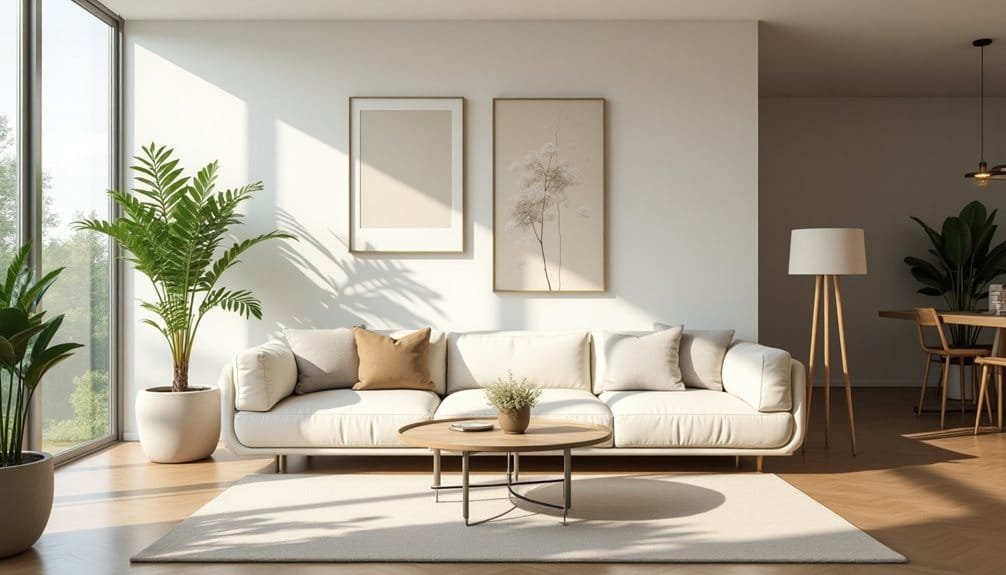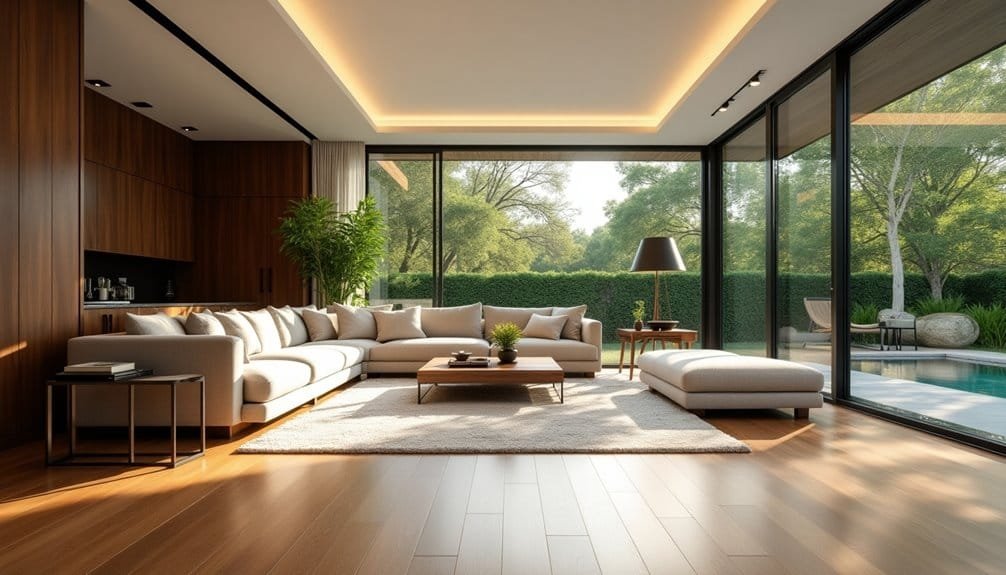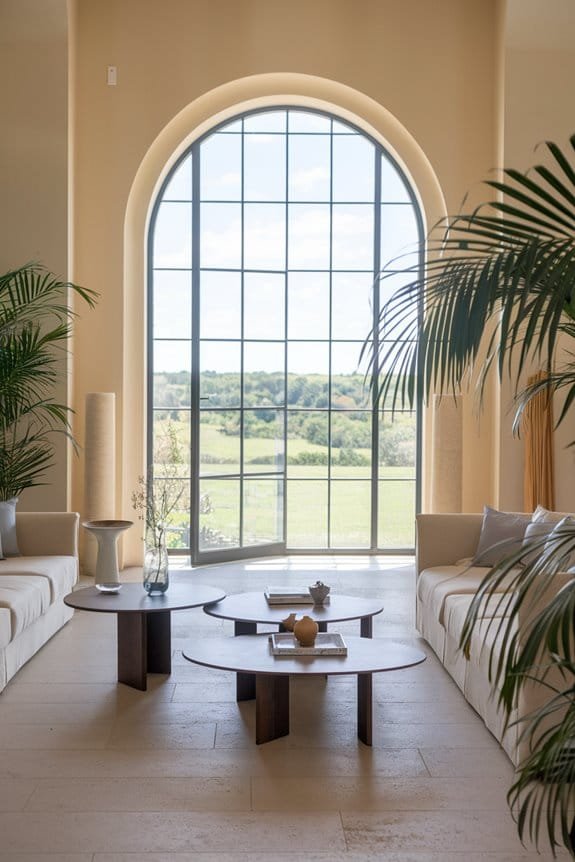To take quality real estate photos, start by investing in a high-quality camera like the Canon EOS 5D Mark IV and versatile lenses for varied shots. Use natural lighting by shooting during the golden hour or enhance with tools like the Yongnuo YN560 IV flash for balanced indoor lighting. Apply the rule of thirds and leading lines to your composition for appealing visual flow, and emphasize unique architectural features using wide-angle lenses. Edit your images meticulously, employing techniques like HDR blending and perspective correction, to produce polished, true-to-life representations of the property. Explore these strategies further to engage potential buyers effectively.
Key Takeaways
- Use high-quality cameras and lenses to ensure sharp, professional images that attract potential buyers.
- Optimize lighting by shooting during golden hour and using artificial light to create appealing, balanced visuals.
- Apply post-processing techniques like HDR blending and color correction for true-to-life representations.
- Employ composition strategies like the rule of thirds and leading lines to create visually engaging photos.
- Stage rooms with furniture and decor to evoke desirable lifestyles and highlight unique property features.
Essential Photography Equipment
To capture stunning real estate photos, having the right photography equipment is vital. The Canon EOS 5D Mark IV is particularly suitable for real estate photography, offering excellent image quality. You might also consider the Canon EOS Rebel SL3 or Nikon D850 for capturing high-quality images. If you prefer mirrorless systems, the Sony Alpha a7R IV is a great option due to its high resolution and durability. For those managing multiple systems, the Black Magic Pocket Cinema 6K provides a versatile alternative. High-quality visuals are essential for attracting potential buyers to a property, making the investment in professional equipment worthwhile.
Lenses are essential for capturing the right perspective. The Canon RF 15-35mm f/2.8L IS USM is perfect for wide interior shots and expansive landscapes. For flexibility, the Canon RF 24-105mm f/4L IS USM covers various scenarios. If you're working in tight spaces, the Canon RF 16mm f/2.8 STM offers a compact and lightweight solution. Notably, the Canon RF 15-35mm f/2.8L IS USM is ideal for wide shots and various perspectives, frequently mentioned as the top choice by users. Sony users can rely on the Sony SEL1224G 12-24 mm f/4-22 for wide angles without distortion.
A sturdy tripod, like the Manfrotto MT055XPRO3, guarantees your shots remain crisp and level, while the Gitzo GT2542 provides high-end stability. Don't overlook accessories like the Yongnuo YN560 IV flash and Rhino ROV Pro Traveler video slider for enhanced shooting capabilities.
Effective Lighting Techniques
With your photography equipment ready, it's time to focus on lighting techniques that transform ordinary real estate images into enchanting showcases. Effective use of both natural and artificial light can greatly enhance the appeal of property photos.
Start by harnessing natural light: shoot exterior images during the golden hour for beautifully warm and diffused lighting. Inside, open windows and curtains to invite as much natural light as possible, making spaces feel bright and inviting. Avoid overcast weather when possible, but use flash units and exposure bracketing for HDR processing if needed. Remember that expert guidance is available for mastering these interior lighting options.
For interior shots, mastering artificial lighting techniques is essential. Bounced flash helps fill rooms with soft, even light, minimizing harsh shadows. Consider including light fixtures in your shots if they add character and warmth. To achieve optimal results, it's important to test the flash power settings and adjust them based on the room's lighting needs.
When managing mixed lighting conditions, a few strategies can help:
- Gelling Techniques: Use gels on artificial lights to match natural hues.
- Exposure Bracketing: Capture multiple exposures for HDR to balance contrasts.
- Light Source Management: Blend window light, fixtures, and flash effectively.
- Post-processing: Refine images by adjusting exposure and color balance.
Addressing common lighting challenges guarantees your photos are consistently high-quality, showcasing properties in their best light.
Mastering Composition

Anyone aiming to capture stunning real estate photos must master composition techniques. Start by maintaining horizontal and vertical lines; they need to be straight and not tilted. Use a tripod or level to achieve perfect horizon lines. Correct vertical lines are essential to make your photos look professional.
Next, apply the rule of thirds by dividing the frame into a 3×3 grid, placing key elements along these lines. This adds visual interest and balances your images, helping guide the viewer's eye naturally. Strong composition is crucial for captivating real estate images, as it enhances property features and tells a property's story visually.
Incorporate leading lines, like staircases or pathways, to create flow and guide viewers through the property. Framing subjects within other elements adds depth and visual interest. Consider using symmetry and single point perspective to convey luxury. Align key elements with a central vanishing point for capturing grand spaces and emphasizing architectural features. Details contribute significantly to the perceived value of the property, so ensure you highlight unique features and finishes that attract potential buyers.
Focus on unique features by highlighting distinctive architectural elements and newly installed features. A minimalist approach helps avoid clutter, making rooms appear larger. Use a wide-angle lens to capture broader views and guarantee your camera is centrally positioned to minimize distortion.
Ultimately, mastering composition techniques elevates your real estate photography, showcasing properties in their best light.
Room-Specific Photography Tips
Capturing each room's unique character is vital in real estate photography. You'll want to focus on different elements to truly showcase the property's potential. For entryways and exteriors, wide shots are essential to encompass the full breadth of the property. Highlight any architectural details to give potential buyers a sense of the home's design. Canon 5D Mark IV is recommended for its ability to produce quality images that highlight these features effectively. Don't forget to include landscape features, as well-maintained gardens can greatly boost a property's appeal. Drone photography can offer stunning aerial perspectives, providing an overview of both the property and its surroundings. Additionally, using professional-quality videos can complement your photography by showcasing properties dynamically.
For interior rooms, accentuate unique features like fireplaces or panoramic views in living rooms. Use wide-angle lenses to capture the dimensions of spaces, making certain kitchens and bedrooms feel expansive. AI tools can enhance property photos by automatically adjusting lighting and colors, ensuring the property looks its best. Staging rooms can help evoke a desirable lifestyle, so arrange furniture and decor thoughtfully.
Pay attention to details like chandeliers or built-in features in dining rooms, as these can add considerable value.
- Bedrooms: Highlight walk-in closets and stage neutrally.
- Bathrooms: Emphasize spa tubs and maintain cleanliness.
- Home offices: Capture custom shelving and desk spaces.
- Outdoor spaces: Use golden hour light for luxury features.
With these tips, you can enhance each room's allure effectively.
Advanced Editing Practices

In the field of real estate photography, advanced editing practices can transform ordinary images into enchanting showcases that draw potential buyers. By mastering techniques like HDR Blending and Color Correction, you'll breathe life into photos, guaranteeing they capture the true essence of the property. Tools such as the Curves Adjustment, Camera Raw Filter, and Luminosity Masks enable you to fine-tune brightness and contrast, offering a polished finish that stands out. Photo editing enhances property appeal, boosts potential sales, creates a professional image, and increases buyer interest in a competitive market.
Consider using the following techniques to evoke emotion and engage your audience:
| Editing Technique | Emotional Impact |
|---|---|
| HDR Blending | Creates a balanced and vibrant atmosphere |
| Sky Replacement | Adds drama and beauty to outdoor scenes |
| Virtual Staging | Helps potential buyers envision themselves |
| Detail Enhancement | Highlights unique property features |
Perspective and Lens Correction guarantee your images are free from distortion, while Object Removal tidies up the scene by eliminating distractions. Advanced techniques such as Sky Replacement and Virtual Staging make spaces appear inviting and personalized. By strategically enhancing details and adjusting colors, you can evoke emotions and create a compelling visual narrative. With these practices, your real estate photos will not only attract attention but also leave a lasting impression. Noise reduction is vital, ensuring your images are clear and crisp, which is crucial for maintaining the quality and professionalism that potential home buyers expect.
Frequently Asked Questions
How Do I Prepare a Property for a Real Estate Photo Shoot?
To prepare a property for a real estate photo shoot, start by cleaning all surfaces and organizing spaces, ensuring everything is tidy and clutter-free.
Turn on lights to brighten interiors, and make beds neatly.
Outdoors, maintain landscaping, hide distracting objects, and clean walkways.
Enhance outdoor lighting and arrange furniture aesthetically.
Inside, clear excess furniture and highlight unique features.
Remove personal items, ensuring the property looks inviting and spacious for potential buyers.
What Time of Day Is Best for Exterior Photos?
Did you know that 80% of potential buyers are attracted to a property based on its exterior photos alone?
The best time for capturing exterior photos is during the golden hour, just after sunrise or before sunset. This time offers soft, warm light that highlights features with long shadows and inviting tones.
Avoid midday when harsh light can create unflattering shadows. Overcast days also work well, providing even, diffused lighting for true colors.
Should I Include Pets in Real Estate Photos?
Including pets in real estate photos can greatly enhance the listing's appeal.
You'll likely attract more attention and shares, especially on social media, as pets can create emotional connections with potential buyers.
However, be cautious—some buyers might perceive pets as signs of damage or allergens.
Limit photos to one or two natural scenes to maintain balance.
This strategy highlights the home's pet-friendliness while avoiding overwhelming potential buyers.
How Can I Handle Reflections in Mirrors and Windows?
When handling reflections in mirrors and windows, adjust your camera angle to bypass unwanted glares, shifting up, down, or sideways.
Turn off unnecessary lights to reduce reflections, and use a polarizing filter for clearer shots.
Block windows when necessary, or utilize scrim to control light.
In post-processing, employ layer masking to blend images seamlessly.
These strategies guarantee you capture the property's true essence without distracting reflections.
What Are Common Mistakes to Avoid in Real Estate Photography?
When tackling real estate photography, avoid common mistakes like not preparing the property thoroughly.
Always let natural light in by opening blinds and curtains. Guarantee you use proper equipment and avoid harsh flash to maintain flattering lighting.
Stabilize your camera with a tripod and correct white balance for accurate colors. Avoid over-editing; keep colors and perspectives natural.
Finally, inform clients about preparation to enhance the property's appeal in photos.
Bottom Line
With your new skills in real estate photography, you're ready to capture spaces that tell a story, transforming ordinary rooms into inviting sanctuaries. Armed with essential equipment and lighting techniques, you've mastered composition and room-specific strategies, enhancing each photograph. As you explore advanced editing, remember that every click of the shutter is an opportunity to showcase the charm and character of a home. Your journey in real estate photography is just beginning, illuminating spaces with creativity and precision.




